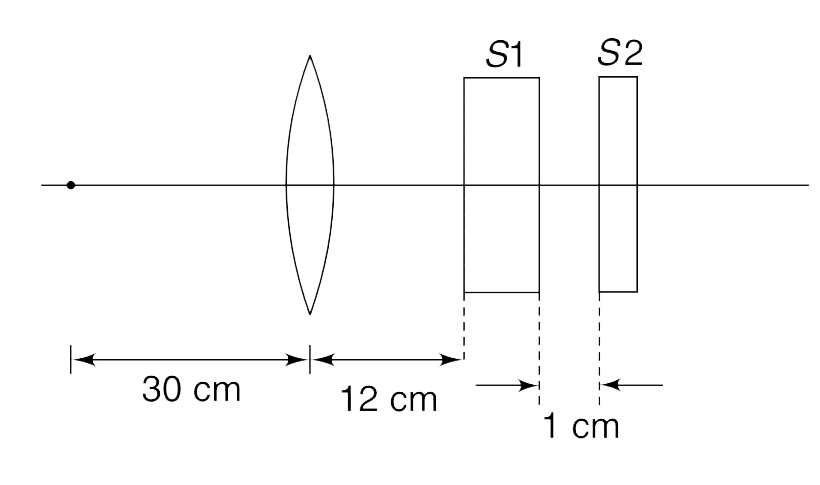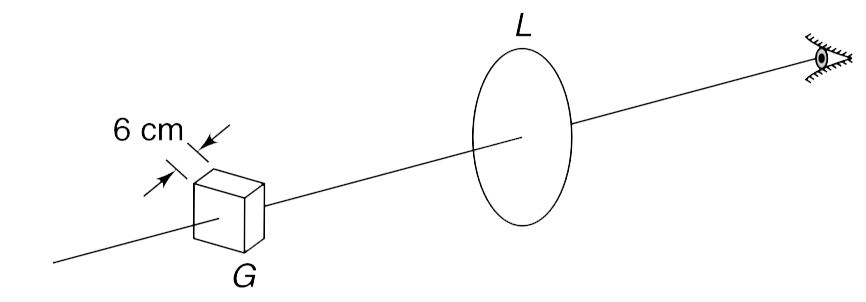A small object (A) is placed on the principal axis of an equiconvex lens at a distance of 30 cm. The refractive index of the glass of the lens is 1.5 and its surfaces have radius of curvature R=20cm. Two glass slabs S1 and S2 have been placed behind the lens as shown in Figure. Thickness of the two slabs is 6 cm and 4 cm respectively and their refractive indices are 32 and 2 respectively.
(a) Find the distance of the final image measured from the lens. Also find the magnification.
(b) How does the position of the image change if the slab S2 is moved to left so as to put it in contact with S1.
(c) How does the position of the image change if the two slabs in contact are together moved to right by a distance of 100 cm.

The correct Answer is:(a) 60cm;m=−2 (b) No change (c) No change
Step by step video, text & image solution for A small object (A) is placed on the principal axis of an equiconvex lens at a distance of 30 cm. The refractive index of the glass of the lens is 1.5 and its surfaces have radius of curvature R = 20 cm. Two glass slabs S1 and S2 have been placed behind the lens as shown in Figure. Thickness of the two slabs is 6 cm and 4 cm respectively and their refractive indices are (3)/(2) and 2 respectively. (a) Find the distance of the final image measured from the lens. Also find the magnification. (b) How does the position of the image change if the slab S2 is moved to left so as to put it in contact with S1. (c) How does the position of the image change if the two slabs in contact are together moved to right by a distance of 100 cm. by Physics experts to help you in doubts & scoring excellent marks in Class 12 exams.
Updated on:21/07/2023Topper's Solved these Questions
- GEOMETRICAL OPTICSBOOK - ARIHANTCHAPTER - GEOMETRICAL OPTICSEXERCISE - Level 3
9 Videos
- GEOMETRICAL OPTICSBOOK - ARIHANTCHAPTER - GEOMETRICAL OPTICSEXERCISE - Level 3
9 Videos
- ELECTROSTATICSBOOK - ARIHANTCHAPTER - ELECTROSTATICSEXERCISE - Level 3
59 Videos
- MAGNETIC EFFECT OF CURRENTBOOK - ARIHANTCHAPTER - MAGNETIC EFFECT OF CURRENTEXERCISE - Magnetic effect of Current
45 Videos
Similar Questions
An object O is placed at 8cm in front of a glass slab, whose one face is silvered as shown in Figure. The thickness of the slab is 6cm. If the image formed 10 cm behind the silvered face, find the refractive index of glass.

View SolutionAn object 50cm tall is placed on the principal axis of a convex lens. Its 20cm tall image is formed on the screen placed at a distance of 10cm from the lens. Calculate the focal length of the lens.
View Solution
Knowledge Check
The radius of curvature of the curved surface of a plano-convex lens is 20cm. If the refractive index of the material of the lens be 1.5, it will
Aact as a convex lens only for the object that lie on its curved side.Bact as a concave lens for the objects that lie on its curved side.Cact as a convex lens irrespective of the side on which the object lies.Dact as a concave lens irrespective of side on which the object lies.An equiconvex lens is made from glass of refractive index 1.5. If the radius of each surface is changed from 5cm to 6cm, then the power
Aremains unchangedBincreases by 3.33DCdecreases by 3.33DDdecreases by 5.5DFocal length of an equiconvex lens is 20 cm. The refractive index of material of the lens is 1.5. Now one of the curved surface is silvered. At what distance from the lens an object is to be placed, so that image coincides with the object ?
A10 cmB20 cmC30 cmD40 cm
A transparent glass slab (G) of thickness 6 cm is held perpendicular to the principal axis of a convex lens (L) as shown in the Figure. The refractive index of the material of the glass is 32 and its nearer face is at a distance 40 cm from the lens. Focal length of the lens is 20 cm. Find the thickness of the glass slab as observed through the lens.

View SolutionA biconvex lens has radii of curvature 20 cm and 40cm. The refractive index of the material of the lens is 1.5. An object is placed 40cm in front of the lens. Calculate the psition of the image.
View SolutionA point object is placed on the principal axis of a convex lens (f = 15 cm) at a distance of 30 cm from it. A glass plate (μ=1.50) of thickness 1 cm is placed on the other side of the lens perpendicular to the axis. Locate the image of the point object.
View SolutionThe radii of curvature of the faces of a double convex lens
are 10 cm and 20. The refractive index of the glass is 1.5.
What is the power of this lens (in units of dioptre)?
View SolutionA double convex lens is made of glass of refractive index 1.5. If its focal length is 30 cm, then radius of curvature of each of its curved surface is
View Solution
